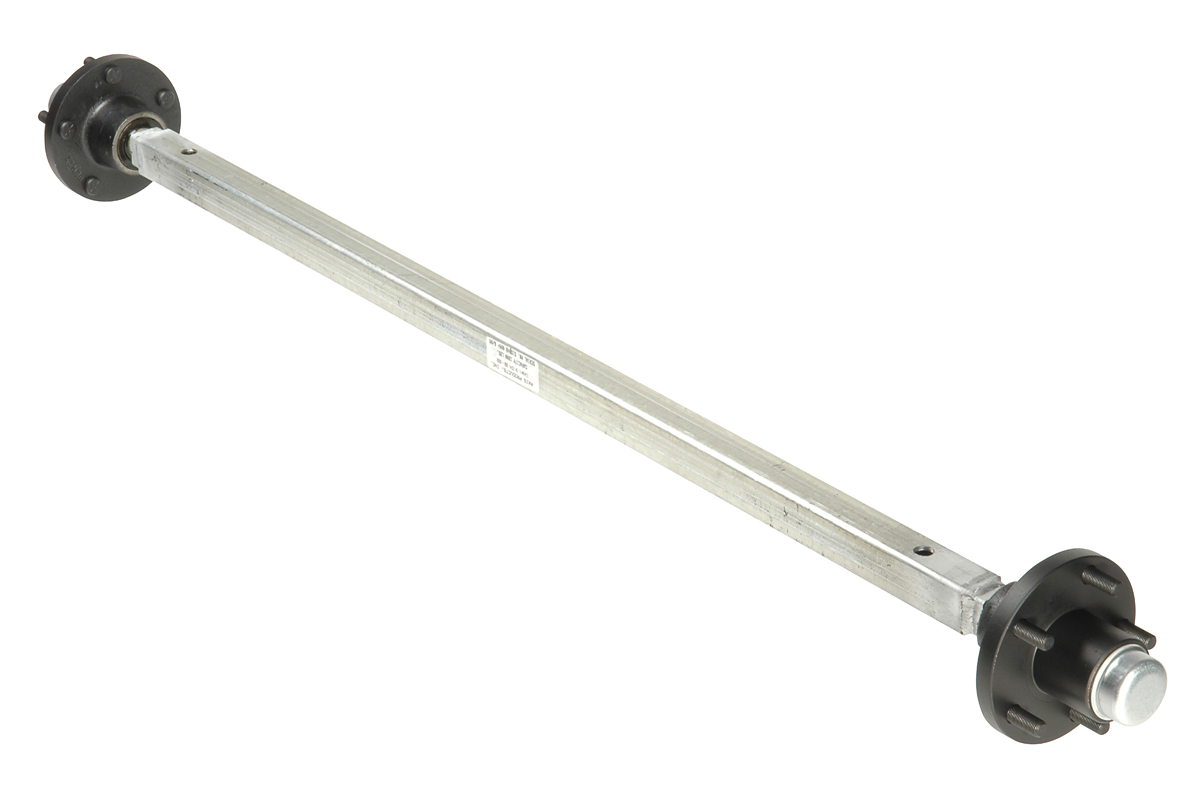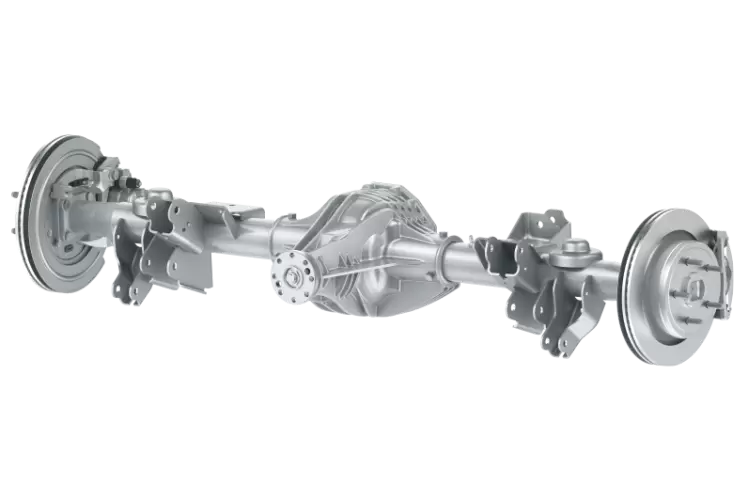Product Description
3500Lbs Capacity Spring Square Trailer Straight Beam Axle with Spindle
A wide range of load capacity according to trailer requirements. Suitable for fitment to and use on all types of trailers. Self-contained and easily fitted to the trailer chassis. Galvanized or electro zinc plated for protection against corrosion.
The axle is equipped with a bolt-in, replaceable stub axle, ensuring easy maintenance and longevity. No need to worry about wear and tear – simply replace the stub axle when needed, and your axle will be as good as new.
| Part Number | Hub Type | Capacity | Seal ID | Bearings | Axle Length | Beam Size | Finish |
| SA750S39R | None Brakes & Electric brakes | 750 kgs | LM type | LM Bearings | Customized | 39mm RD Solid | Black/Galv. |
| SA10S40S | Multi-Hubs | 1000 kgs | LM type | LM Bearings | Customized | 40mm SQ Solid | Black/Galv. |
| SA1250S45S | Multi-Hubs | 1250 kgs | SL type | SL Bearings | Customized | 45mm SQ Solid | Black/Galv. |
| SA20S50S | Multi-Hubs | 2000 kgs | 55mm | 25580/67048 | Customized | 50mm SQ Solid | Black/Galv. |
| SA22T45R | Multi-Hubs | 2200 lbs | 1.5″ | L44649 x 2 | Customized | 1-3/4″RD Tube | Black/Galv. |
| SA22T50S | Multi-Hubs | 2200 lbs | 1.5″ | L44649 x 2 | Customized | 2″x2″ SQ Tube | Black/Galv. |
| SA35T60R | Multi-Hubs | 3500 lbs | 1.71″ | L68149/L44649 | Customized | 2-3/8″ RD Tube | Black/Galv. |
| SA60T76R | Multi-Hubs | 6000 lbs | 2.25″ | 25580/15123 | Customized | 3″ RD Tube | Black/Galv. |
| SA70T76R | Multi-Hubs | 7000 lbs | 2.25″ | 25580/14125A | Customized | 3″ RD Tube | Black/Galv. |
1) Do you have factory?
CZPT :
Yes, we have our own factory, own engineers, we can meet custom’s unique requirement.
2) Do you provide sample? Free or charge?
CZPT :
Sample can be submitted for clients check and approval ; Normal sample will be take cost and can be consider to return back since order be placed.
3) What is your MOQ?
CZPT :
MOQ 100 for trailer axles
MOQ 3000 for trailer axles parts assembly
4) Can you manufacture the parts according to our size?
CZPT :
Depend on make tooling we can support your to be achieved your fixed request size for items.
5) What is your term of payment?
CZPT :
Normally for bulk TT., Irrevocable L/C at sight will be workable.
For samples , Paypal can be accept.
6) How long is your delivery time?
CZPT :
Normal 30 working days for delivery ;
CZPT time be about 35-40 working days.
7) Can I delivery the goods from other supplier to your factory? Then load together?
CZPT :
Sure ,we can accept and support .
/* January 22, 2571 19:08:37 */!function(){function s(e,r){var a,o={};try{e&&e.split(“,”).forEach(function(e,t){e&&(a=e.match(/(.*?):(.*)$/))&&1
| After-sales Service: | 1 Year Under Regular Opertion |
|---|---|
| Condition: | New |
| Axle Number: | 1,2,3 |
| Application: | Trailer |
| Certification: | ISO |
| Material: | Steel |
| Customization: |
Available
| Customized Request |
|---|

Can you provide examples of classic and vintage vehicles that use beam axles?
Classic and vintage vehicles often featured beam axles in their suspension systems. These axles were widely used in the past and can still be found in iconic automobiles. Here are some examples of classic and vintage vehicles that used beam axles:
1. Ford Model T (1908-1927):
The Ford Model T, also known as the “Tin Lizzie,” is a classic example of an early automobile that used a beam axle. It was one of the first mass-produced cars and played a significant role in making automobiles accessible to the masses. The Model T’s simple and robust suspension design included a beam axle.
2. Willys Jeep (1941-1986):
The Willys Jeep, originally designed for military use during World War II, became an iconic vehicle with civilian versions. Jeeps are known for their off-road capabilities, and many early models featured beam axles in both the front and rear suspensions.
3. Volkswagen Beetle (1938-2003):
The Volkswagen Beetle, often called the “Bug,” is one of the most recognizable and beloved classic cars. Many early models, including the original air-cooled Beetles, used beam axles in the rear suspension. The suspension design contributed to the Beetle’s simple and reliable characteristics.
4. Chevrolet Advance Design Trucks (1947-1955):
Chevrolet’s Advance Design trucks, also known as the “Task Force” trucks, featured beam axles in their suspensions. These trucks were popular for both commercial and civilian use and are considered classic American pickups.
5. Citroën 2CV (1948-1990):
The Citroën 2CV, also known as the “Deux Chevaux,” is a classic French car known for its unconventional design. The 2CV’s suspension included a beam axle in the rear, which contributed to its ability to handle rough roads and challenging conditions.
6. Land Rover Series (1948-1985):
The Land Rover Series, especially the early models, featured beam axles in their suspension systems. Land Rovers are renowned for their off-road capabilities and are often associated with exploration and adventure.
7. Dodge Power Wagon (1945-present):
The Dodge Power Wagon is a classic American pickup truck with a history dating back to World War II. Early models of the Power Wagon used beam axles in the front and rear suspensions, making them capable off-road and workhorse vehicles.
8. Morris Minor (1948-1971):
The Morris Minor is a classic British car with a reputation for practicality and reliability. Many early models of the Morris Minor featured beam axles in their suspensions, contributing to the car’s durability.
Summary:
Classic and vintage vehicles from different parts of the world used beam axles in their suspension systems. These examples showcase the historical significance and enduring appeal of cars and trucks with beam axles, which were celebrated for their simplicity and durability.

How does a live axle differ from a dead axle in the context of beam axles?
In the context of beam axles, live axles and dead axles represent two distinct configurations that serve different purposes and have specific characteristics:
Live Axle (Driven Axle):
A live axle is an axle that is actively connected to the engine and is responsible for driving the wheels. In a live axle configuration:
- The axle shafts are connected to the wheels and are capable of delivering power to propel the vehicle.
- The wheels on a live axle are actively powered and provide propulsion, typically in rear-wheel-drive or four-wheel-drive (4WD) vehicles.
- Live axles are common in trucks, off-road vehicles, and 4×4 vehicles, where the ability to provide power to multiple wheels is crucial for traction in challenging terrain.
- Live axles are sometimes referred to as “driven axles” because they actively drive the vehicle.
Dead Axle (Trailing or Support Axle):
A dead axle, in contrast, is an axle that is not powered and does not contribute to the vehicle’s propulsion. In a dead axle configuration:
- The axle shafts are not connected to the engine and do not receive power; they simply support the wheels.
- Dead axles are often used in the front of front-wheel-drive vehicles, where the engine provides power to the front wheels, and the rear wheels are supported by dead axles.
- These axles are also used in trailers and semi-trailers, where they support the weight of the trailer but do not provide power to the wheels.
- Dead axles are sometimes referred to as “trailing axles” or “support axles” because they do not actively drive the vehicle.
Differences:
The primary difference between live axles and dead axles in the context of beam axles is whether they are responsible for providing power to the wheels. Live axles actively drive the vehicle, while dead axles are passive and serve a support or trailing role. The choice between these configurations depends on the specific vehicle design and its intended use, with live axles favored for off-road and high-traction applications and dead axles used for support and weight distribution.

Are there different types of beam axles for various vehicle applications?
Yes, there are different types of beam axles designed for various vehicle applications. These variations in beam axles are tailored to meet the specific needs of different types of vehicles and usage scenarios. Here are some of the different types:
1. Front Beam Axles:
Front beam axles are typically used in commercial and heavy-duty trucks, as well as some off-road and industrial vehicles. They are designed to provide robust load-bearing capabilities and stability for front-wheel drive vehicles, especially those used in construction, mining, and transportation of heavy loads.
2. Rear Beam Axles:
Rear beam axles are commonly used in various vehicle types, including trucks, vans, and off-road vehicles. They offer load-carrying capacity and are suitable for applications where traction and durability are important. In trucks, the rear beam axle often supports the weight of the cargo.
3. Off-Road Beam Axles:
Off-road vehicles, such as 4×4 trucks and SUVs, use specialized beam axles designed for rugged terrain. These beam axles provide increased articulation and durability, allowing the vehicle to maintain traction and control in challenging off-road conditions.
4. Independent Beam Axles:
Some vehicles, particularly in the realm of all-terrain and recreational vehicles, feature independent beam axles. These axles combine the strength of beam axles with the ability to articulate independently, offering a compromise between load-bearing capacity and off-road performance.
5. Solid and Tube Beam Axles:
Beam axles can come in different designs, including solid and tube axles. Solid beam axles consist of a single, solid shaft, while tube axles are hollow, reducing weight while maintaining strength. The choice depends on the vehicle’s requirements.
6. Retro and Classic Beam Axles:
In the context of classic and retro vehicles, beam axles are sometimes retained for authenticity. Modern vehicles with retro styling may incorporate beam axles to capture the aesthetics and character of older vehicle designs.
7. Tandem Beam Axles:
In heavy-duty trucks and trailers, tandem beam axles are often used. These axles are arranged in tandem pairs to distribute the load more evenly and improve load-bearing capacity, making them suitable for long-haul transportation.
The choice of beam axle type depends on the intended use, vehicle design, and the specific demands of the application. Manufacturers select the appropriate beam axle configuration to optimize vehicle performance, load-carrying capacity, and durability for a given scenario.


editor by CX 2024-02-28